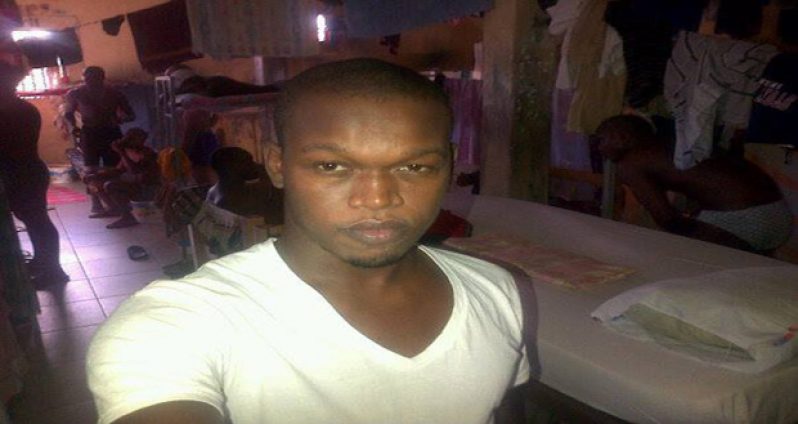By Shauna Jemmott
AFTER a horrifying experience witnessing the burning of the Camp Street jail block, several men burnt beyond recognition, rescuing many and losing his best friend, Government has made counselling available to Camp Street prisoner Steve Bacchus, whose bravery has not gone unrecognised.Bacchus, a prisoner residing in the Old Capital Block, testified last week before the Commission of Inquiry (CoI) into the Georgetown prison riot, and accepted an offer for psychotherapy after Chairman of the Commission, retired Justice James Patterson, and Barrister-at-Law Selwyn Pieters, who is representing the Joint Services in the CoI, enlightened him on the importance of such therapy.
He is currently serving a two-year sentence for escaping from lawful custody, and had also been remanded to prison facing multiple charges, including murder.

While he was a remanded prisoner facing multiple charges, he, along with Randolph Marks and another prisoner, escaped from lawful custody at the Georgetown Magistrates’ Court on May 19, 2014. While the other prisoner was shot dead, he and Randolph Marks were caught, and sentenced by then Chief Magistrate Priya Beharry.
Bacchus was also accused of the January 24, 2014 murder of police constable Quincy Wright of Mahaicony, at the home of his girlfriend Alicia Adams at Guyhoc Park. He was also charged with the attempted murder of security guard Mortimer Maynard, and the theft of a firearm along with live rounds of ammunition from another security guard on January 23.
It was under cross-examination by Pieters that the prisoner disclosed that he had received no counselling since the dreadful prison fire.
POST-TRAUMATIC STRESS
He is having signs of post-traumatic stress after also seeing the skull of a beheaded prisoner burnt on a bed after the fire. The head was separated from the individual’s body, and speculations are that someone may have been beheaded in the jail dormitory before it was burnt.
Bacchus said he would often have flashbacks of what he experienced and cry in his bed, but he had not experienced nightmares, sleeplessness or eating disruptions.
Justice Patterson informed the prisoner that counselling services have been made available by the Commission, which was established by Government to inquire into the deadly riots and conditions at the jail; and he was advised that since his experience would have long-term psychological effects, he should be one to benefit from such service.
The CoI Chairman assured Bacchus that any information he relays to the counsellors would be voluntary, since he would not be forced to say anything he does not want to say.
While the entire CoI panel and lawyers seemed supportive of the gesture, Pieters also assured Bacchus that he needed “some form of intense counselling”.
“It’s trauma, sir, and we would need that if we went through the trauma that you went through,” the lawyer told the prisoner, as he agreed to undergo counselling.
Bacchus did not participate in lighting fires in the riotous eruptions at the Camp Street penitentiary during March 2 to 4, but broke out of his own prison dormitory, along with others, in a successful attempt to rescue those who had cried for help.
TOO LATE
He said that although it was too late to save his best friend Jermain Otto, whom he fondly called “Fungus”, he was instrumental in soliciting the help of prison officers to open the door after running to the back door and recognising that men were still alive in the blazing building.

After a prison officer turned the lock open with a key, he said, he and others kicked in the bottom of the door, thereby gaining entry into the room which was still in heat. He rescued injured prisoner Owen Belfield, who was at the time kneeling helplessly, and Marcellus Verbeke, who, propped up by Bacchus, limped out of the building.
He also helped in leading Michael Lewis and all of the other survivors out of the fire; and along with another prisoner, fetched Rayon Paddy to an ambulance. Paddy, who died on his way to the hospital, was breathing slowly at the time, but suffered burns that made it impossible for him to survive, Bacchus said.
Bacchus then returned alone inside Capital ‘A’, searching for his friend Otto. He said he cried bitterly as he searched through the bodies and was unable to pinpoint which of the ‘more than 11’ he noticed burnt beyond recognition was that of Otto.
It was then he noticed the bodies of Rudolph Marques (who was in the bathroom) and Ashraf Ali in a toilet dead. He also noticed Shaka McKenzie face down on Primo’s leg just in front the door, and about 11 piled in one corner.
“I see a skull on a bed frame,” was his revelation before the Commission while under cross-examination by Pieters. He said the head was severed from the body and burnt out, but he does not believe the prisoner was beheaded before the fire, but assumed that that his head was burnt off.



.jpg)









